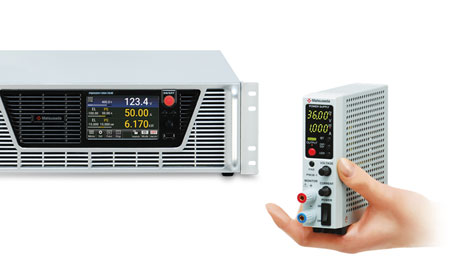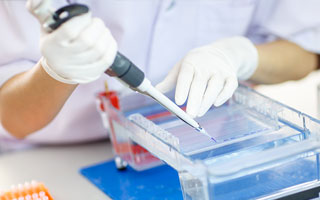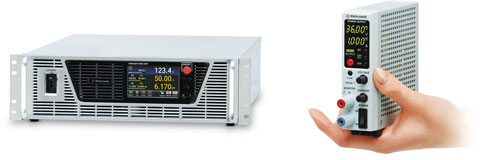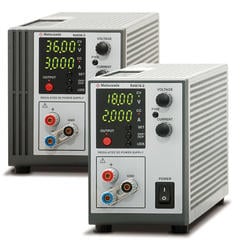DC power supplies are essential in almost every industry. They provide the stable, adjustable direct current (DC) needed for everything from testing electronics to powering critical devices. With precise control over voltage and current, they ensure both optimal performance and reliability.
This guide explores the fundamentals of DC power supplies, including their types, applications, and the importance of selecting the right model for specific needs. Additionally, we briefly review Matsusada Precision's range of DC power supplies, highlighting their features and benefits for various industries and research fields.

Types of DC Power Supplies
DC power supplies serve numerous industries and applications, providing a steady stream of direct current for various purposes. From powering electronic devices to driving industrial machinery, they play a crucial role in modern technology and infrastructure. Understanding the different types of DC power supplies can help tailor solutions to specific needs.

Linear power supplies are among the simplest types, offering stable output voltages but at the expense of efficiency and size. They find applications in audio amplifiers, laboratory equipment, and other scenarios where precise voltage regulation is paramount.
Switched-mode power supplies (SMPS) are more complex but offer higher efficiency and a compact footprint. They are widely used in consumer electronics, telecommunications, and renewable energy systems due to their ability to handle a wide range of input voltages and provide regulated output.
Programmable DC power supplies add another layer of versatility, allowing users to dynamically set voltage and current levels. This flexibility is invaluable in testing, research, and development environments with diverse power requirements.
Specialized DC power supplies cater to specific needs, such as high-voltage power supplies for medical imaging equipment or uninterruptible power supplies (UPS) for critical infrastructure. These tailored solutions ensure reliable power delivery in diverse applications, driving innovation and progress across industries. We explore some common applications of DC power supplies in specific industries.
By Circuit and Size Types
Matsusada Precision's DC power supplies are tailored to diverse needs through distinct control methods. Switching regulator types offer compact efficiency, while linear regulators ensure precise, low-noise outputs. Rackmount supplies maximize space for high power, and bidirectional, regenerative units optimize energy use by merging supply and load functions. This range showcases Matsusada's dedication to providing versatile, high-tech power solutions across various applications.
Benchtop DC power supplies (switching regulator type)
Switching regulator DC power supplies, also known as switching mode power supplies (SMPS), utilize a switching mechanism for efficient voltage regulation, resulting in compact, highly efficient units with minimal heat generation. These power supplies can introduce ripple noise, but this can be mitigated with proper design and filtration. Matsusada Precision's offerings in this category are adjustable, programmable DC power supplies that accept a wide range of AC inputs globally, converting them to a specified DC output within a range of 0.2 W to 1,200 W, 2V to 1 kV voltage, and 0.1 to 180 A current. This versatility makes them suitable for a diverse array of applications across industrial, commercial, and academic settings.
Benchtop DC power supplies (linear regulator type)
Linear regulator benchtop DC power supplies utilize a straightforward circuit design incorporating power transformers, diodes, and linear voltage regulators for converting AC to DC with precise voltage outputs. These supplies are characterized by their ability to generate minimal ripple and noise, making them ideal for sensitive applications, despite their tendency to produce significant heat, which is counteracted in Matsusada's designs through efficient heat dissipation mechanisms. Matsusada offers the high-power R4G/R4GN series (12 W to 180 W) and the low-power, programmable R4GT series (0.1 W to 7.2 W), catering to a range of applications with features like high resolution and precise current control. Although bulkier due to the need for large heat sinks, especially in models above 108 W, these supplies are favored for applications requiring ultra-low noise and fast response, such as sensitive analog and RF circuits, biomedical devices, and precision voltage referencing, offering reliability and flexibility for various industrial, laboratory, testing, and research uses without the need for mechanical anchoring.
Rackmount DC power supplies (switching regulator type)
Rackmount DC power supplies, optimized for standard electronic racks, deliver high power efficiency in a compact format, making them suitable for diverse applications from industrial to research settings. Matsusada's range spans from 0.75 kW half rack to 15 kW in 3U height per unit, extendable to 120 kW with multiple units, capable of handling currents up to 6,000 A and voltages up to 1.5 kV. These supplies feature master-slave control for synchronized operation, noise management, and enhanced visibility displays. They are lightweight for easy rack integration and support standard and industrial communications for remote control and system integration. With built-in safety mechanisms, they offer a versatile solution for high-density power needs in both industrial and laboratory environments.
Bidirectional, Regenerative power supplies
Matsusada Precision's bidirectional DC power supplies integrate both DC power supply and electronic load functions in one compact, high-efficiency unit, leveraging advanced semiconductor technology and air-through circuitry. These regenerative supplies not only supply power but also feed it back to the AC line during load operations, optimizing energy use. Designed for a variety of applications, they are ideal for testing inverters, converters, motors, and chargers for electric vehicles and motorcycles, as well as for use with home-to-vehicle devices and renewable energy systems. This versatility allows for seamless charge/discharge testing of batteries and can simulate battery operations, serving as an effective battery simulator without the need for reconnection.
By Applications
DC power supplies find diverse applications across various industries, powering critical equipment and systems. Here's a look at how these power supplies are utilized in different sectors:
Research and Development
DC power supplies are fundamental in research and development environments, facilitating precise control over voltage and current levels. They are crucial for powering experimental setups, testing electronic components, and conducting various scientific investigations. Beneficiaries include laboratories, Institutes, and research facilities such as particle accelerators.

Energy/Environment
DC power supplies are vital in testing and monitoring equipment in the energy and environmental sectors. They are used in battery simulation, development of renewable energy systems, fusion energy generation, and other applications that require stable and adjustable DC power sources.

Vehicles/Aerospace
DC power supplies are essential for testing and powering avionics, aircraft systems, and electric vehicles in the automotive and aerospace industries. They provide the necessary power for critical onboard electronics and control units.

Semiconductors (Process Control/Burn-In)
Semiconductor manufacturing relies heavily on DC power supplies for process control and burn-in testing. These power supplies ensure precise voltage and current regulation during the fabrication of semiconductor devices.

Medical/Biology
In medical and biological research, DC power supplies are used for various applications such as electrophoresis, cell separation, and imaging techniques like MRI and CT. They provide the necessary power for diagnostic and research equipment.

Analytical Instruments
Analytical instruments, including mass spectrometers, spectroscopy devices, X-ray analysis, and electron microscopes, require stable and reliable DC power supplies for accurate measurements and analyses.

Electronics
DC power supplies are used for various applications in the electronics industry, including testing electronic components, powering circuits, and driving motors. They are vital for the proper functioning of electronic devices and systems.

These examples showcase the versatility and importance of DC power supplies across different industries and applications, highlighting their role in powering critical equipment and enabling technological advancements.
Reference of DC voltage
DC power supplies are crucial in various industries and applications, providing stable and reliable power for various devices and systems. Here, we explore the specific applications of DC power supplies at different voltage levels.
- 1.2 V
-
Nickel-metal hydride battery
The nominal voltage of a nickel metal hydride (NiMH) battery is 1.2 V. Nickel metal hydride (NiMH) batteries are rechargeable and are used as rechargeable dry cell batteries. Although their voltage is lower than that of ordinary dry cell batteries, they can be used in most devices that operate on dry cell batteries, as most of them can be used even when the voltage drops to about 0.9V. However, if three or four batteries are connected in series, the voltage difference will be too large for some devices to operate.
- 1.5 V
-
Alkaline and zinc-carbon batteries (for consumers)
The 1.5 V DC voltage is the nominal voltage of single, D-size, C-size, AA, and AAA dry cell batteries, as well as alkaline button batteries. The voltage of alkaline and manganese dry cell batteries will decrease as they are used.
- 2.0 V
-
Lead-acid battery (1 cell)
The 2.0 V DC voltage is the nominal voltage of a single-cell lead-acid battery. (It is sometimes defined as 2.1 V.) Lead-acid batteries installed in automobiles and other vehicles consist of six cells connected in series to form a 12 V lead-acid battery. These batteries are commonly used in emergency lighting, security, and small-scale renewable energy systems.
- 3.3 V
-
Signal voltage of electronic circuits, ATX power supply
The 3.3 V DC voltage has become a standard voltage of sorts in electronic logic circuits. It is also one of the voltages supplied by ATX power supplies for desktop computers.
- 3.7 V
-
Lithium-ion battery
Lithium-ion batteries, which are widely used in smartphones, tablets, and laptop computers, have a nominal voltage of 3.7 V DC for a single cell. In a lithium-ion battery pack, these cells are stacked in series or parallel to increase voltage and capacity. In many cases, they are combined with ICs for control due to the risk of explosion or ignition in the event of overcharge or overdischarge.
- 5 V
-
Signal voltage of electronic circuits, USB voltage, ATX power supply
5 V DC voltage is the voltage used in many electronic devices such as electronic circuits, USB devices, and ATX power supplies. Logic circuit voltages include a +5V Transistor-Transistor Logic (TTL) signal level and a +3.3V signal level. It provides 5V power to a wide variety of consumer electronics and peripherals, allowing them to function optimally. While conventional USB is only 5 V, USB PD (USB type-C) has five basic voltages: 5 V, 9 V, 15 V, 20 V, and 48 V, depending on the power used.
- 9 V
-
Rectangular alkaline battery
9 V DC voltage is typically supplied by square alkaline batteries. They provide power for devices such as smoke detectors, guitar pedals, digital multimeters, and electronic toys.
- 12 V
-
Lead-acid battery, vehicular equipment, ATX power supply (±12V)
12 V DC voltage is used in lead-acid batteries, automotive equipment, and ATX power supplies (providing ±12 V). They are used in a variety of automotive and electronic equipment with moderate power requirements.
- 15 V
-
Operational amplifier power supply (±15V)
15 V DC voltage is often used to power operational amplifiers, providing stable power for audio equipment, signal processing circuits, and other precision electronic devices.
- 24 V
-
Common voltage for electrical equipment, voltage for truck and other large vehicle batteries
24 V DC voltage is commonly used inside electrical equipment and in large vehicle batteries.
- 48 V
-
Telephone lines (-48 V), power over ethernet (POE) supply (44 to 57 V), telecommunications equipment, mild hybrid
48 V DC voltage is used for telephone lines, power over Ethernet (POE) supply voltage, telecommunications equipment, and mild hybrid vehicles. 48VDC power is also used in condenser microphones, mixers, and musical instruments, where it is called phantom power.
- 60 V
-
Boundary of hazardous voltage
The 60 V output represents the boundary of the hazardous voltage. DC voltages at this level are used in special applications requiring higher voltages.
- 380 V
-
High voltage direct current (HVDC) supply for data centers
380 V DC voltage is used for high-voltage direct current (HVDC) supply for data centers. In these critical facilities, AC to DC conversion losses are reduced to enable a more efficient and reliable power distribution system.
- 600 V - 1500 V
-
Direct current supply for electric trains in Japan
The standard voltages for DC-powered trains in Japan are 600V, 750V, and 1500V.
Selecting the Right Model
When selecting the right DC power supply model, consider the output range and circuit method. The output range involves choosing between single-range(fixed range) and wide-range(a.k.a. wide range, variable range, auto-ranging) systems. Single-range supplies are cost-effective for fixed voltage or current needs but lack flexibility. Wide range power supplies provide versatility with different voltage and current combinations and are useful for multiple devices that require different input voltages or the need for multiple power supplies in the future. It can save cost and space, but you need to check the range width.
Circuit methods include the linear (dropper) and switching methods. Dropper supplies offer low noise and high responsiveness, suitable for noise-sensitive applications, but are larger, heavier, and generate more heat. Switching supplies, prevalent in devices like desktop computers, are compact and efficient but produce minute noise, potentially affecting sensitive equipment.
For a detailed guide on selecting the appropriate DC power supply for your needs, including considerations for output range, circuit methods, and other crucial factors, be sure to visit one of our columns: " How to Choose a DC Power Supply: Key Points to Consider"
Matsusada Precision DC Power Supplies
Matsusada Precision is a leading provider of high-quality DC power supplies known for their precision, reliability, and innovation. Their range of DC power supplies caters to diverse industries and applications, offering solutions for research, development, and industrial needs.

Matsusada's DC power supplies are designed to meet the stringent requirements of modern electronics, offering precise voltage and current control, low noise, and high stability. Whether for laboratory testing, semiconductor manufacturing, or aerospace applications, Matsusada's power supplies deliver consistent performance and durability.
Focusing on excellence and customer satisfaction, Matsusada Precision continues to push the boundaries of DC power supply technology, ensuring that its products meet the evolving needs of the industry. Whether you require a standard off-the-shelf solution or a custom-designed power supply, Matsusada Precision has the expertise and experience to deliver reliable power solutions tailored to your specific requirements.
Product LineBasics of DC Power Supplies
Direct current (DC) power supplies convert alternating (AC) to a stable, constant voltage or current output. They are essential for powering electronic devices and circuits that require a steady DC power source.
What Is a DC Power Supply?
A DC power supply is a device that converts AC voltage from a power source into DC voltage. It provides a stable and continuous supply of DC power to electronic devices, ensuring they operate correctly. DC power supplies come in various types, including linear, switched-mode, and programmable, each with advantages and applications. For deeper understanding, learn more in our article, " An Introduction to DC Power Supplies ".
What is the Difference Between DC and AC Power Supplies?
The main difference between DC and AC power supplies is the type of current they provide. AC power supplies produce alternating current, periodically changing direction, while DC power supplies provide direct current, which flows in one direction only. This difference in current type is crucial for different types of electronic devices, as some require DC for operation. For a comprehensive explanation of these electrical concepts, please refer to our detailed guide: ' Difference between DC power and AC power'.
What Is a Programmable DC Power Supply?
A programmable DC power supply is a type of DC power supply that allows users to set the output voltage and current levels. It provides greater flexibility and control compared to traditional fixed-output power supplies. Programmable power supplies are often used in testing and development environments where precise control over the power output is required. Learn more about the advantages and applications of programmable DC power supplies in our resource, ' Programmable Power Supply 101'
How Is DC Current/Power Generated?
DC is generated using rectifiers, which convert AC voltage into DC voltage by allowing current to flow in only one direction. This process ensures a constant flow of current, making it suitable for powering electronic devices that require stable power. DC power supplies often incorporate additional circuitry, such as voltage regulators, to ensure the output voltage remains uniform even when the input voltage or load changes. For detailed explanation, visit ' Method of Generating Direct Current (DC) Power'.












